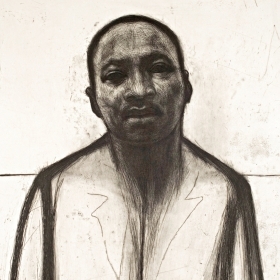Photo by Richard Howard
Assistant Professor of Art Nikki Greene likes to think outside the classroom. Art History 316, The Body: Race and Gender in Modern and Contemporary Art, is held in a small, dimly lit seminar room in Jewett overlooking Severance Green, but it’s possible for anyone in the world to listen in on the discussions that happen there by searching for #ARTH316 on Twitter.
Before a class that included discussion of Abigail Solomon-Godeau’s essay “Going Native: Paul Gaugin and the Invention of Primitivist Modernism” and Adrian Piper’s “The Triple Negation of Colored Women Artists,” students tweeted incisive and potent reactions to the readings. One student tweeted: “Primitivism is a gendered, colonial discourse. Gaugin’s art consumes the brown female body and spits out the bones.” Another commented, “Why should WOC artists have to embrace the postmodern moment when Western modernism operated on their invisibility? #AdrianPiper”
Greene requires that everyone in ARTH 316 tweet a summary or cogent point about the week’s readings. “Twitter really forces you to get to the point. What are the crucial elements of this article? … I’m amazed at what they can come up with,” she says. Greene also likes that by taking the conversation online, students can break beyond the confines of Wellesley.
When you’re teaching a course on race and gender, the outside world also has a way of coming into the classroom. “The challenge is that there are always new incidents where we have to think about race more critically,” Greene says.
When Greene first taught the course in 2012, the class discussed Trayvon Martin, the 17-year-old who was fatally shot by George Zimmerman, a neighborhood watch volunteer, in February 2012. “[At the time,] we were talking about Trayvon Martin, and what his image meant, and the repetition of the image of him in the hoodie,” she says. Now, four years later, that image is still echoing through American culture. She points to Claudia Rankine’s 2014 meditation on racism, Citizen: An American Lyric, which is a reading in this year’s class. The cover of Citizen is actually a photo of an unsettling 1993 piece of artwork by David Hammons, In the Hood, which consists of a hood cut from a sweatshirt and hung on a wall.






We ask that those who engage in Wellesley magazine's online community act with honesty, integrity, and respect. (Remember the honor code, alums?) We reserve the right to remove comments by impersonators or comments that are not civil and relevant to the subject at hand. By posting here, you are permitting Wellesley magazine to edit and republish your comment in all media. Please remember that all posts are public.